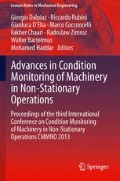Abstract
One of the standard approaches widely used in the field of localized gear tooth fault diagnosis is the creation of residual signals i.e. signals obtained after removing the deterministic frequency components from a Time Synchronously Averaged vibration signals. Most of the time these components are removed based on the knowledge of the characteristic gearbox frequencies. Sometimes however such information is not available. AR modeling, a type of time series modeling, has been found to be capable of faithfully estimating the deterministic content of the signal allowing meaningful residual signals to be created. An improvement to the classic AR modeling approach is proposed in this text. The method is applied to experimental data taken from a gearbox in both healthy and faulty condition. The improvement derived from the new method is quantified through a comparison with results obtained by applying Time Synchronous Averaging and the classic AR modeling method to the experimental data.
Access this chapter
Tax calculation will be finalised at checkout
Purchases are for personal use only
References
Matignon R (2005) Neural network modeling using Sas enterprise miner. AuthorHouse
Barreto H, Howland FM (2005) Introductory econometrics. Cambridge University Press, Cambridge
Wang W, Wong AK (2000) Model-based gear diagnostic techniques, DSTO Technical Report 1079. doi: DST 98/164
Wang W, Wong AK (2002) Autoregressive model-based gear fault diagnosis. Trans ASME J Vib Acoust 124:172–179. doi:10.1016/j.jsv.2009.07.004
Endo H, Randall RB (2007) Enhancement of autoregressive model based gear tooth fault detection technique by the use of minimum entropy deconvolution. Mech Syst Sig Process 21(2):906–919. doi:10.1016/j.ymssp.2006.02.005
Wang X, Makis V (2009) Autoregressive model-based gear shaft fault diagnosis using the Kolmogorov-Smornov test. J Sound Vib 327(3–5):413–423. doi:10.1016/j.jsv.2009.07.004
Hochmann D, Bechhoefer E (2003) Gear tooth crack signals and their detection via the FM4 measure in application for helicopter HUMS (Health Usage and Management System). Proceedings of the aerospace conference, vol 7. pp 3313–3326. doi:10.1109/AERO.2003.1234175
Rzeszuciński PJ, Sinha JK, Edwards R, Starr A, Allen B (2012) Amplitude of probability density function (APDF) of vibration response as a robust tool for gearbox diagnosis. Strain 48(6):510–516. doi:10.1111/j.1475-1305.2012.00849.x
Percival DB, Wladen AT (1993) Spectral analysis for physical applications: multitaper and conventional univariate techniques. Cambridge University Press, Cambridge
Broersen PMT (2006) Automatic autocorrelation and spectral analysis. Springer, Berlin
McFadden PD (1985) Low frequency vibration generated by gear tooth impacts, non-destructive testing (NDT). International 18(5):279–282. doi:10.1016/0308-9126(85)90008-2
Combet F, Gelman L (2011) Novel adaptation of the demodulation technology for gear damage detection to variable amplitudes of mesh harmonics. Mech Syst Sig Process 25:839–845. doi:10.1016/j.ymssp.2010.07.008
Sörnmo L, Laguna P (2005) Bioelectrical signal processing in cardiac and neurological applications. Academic Press, London
Ottewill JR, Orkisz M (2013) Condition monitoring of gearboxes using synchronously averaged electric motor signals. doi:10.1016/j.ymssp.2013.01.008
Author information
Authors and Affiliations
Corresponding author
Editor information
Editors and Affiliations
Rights and permissions
Copyright information
© 2014 Springer-Verlag Berlin Heidelberg
About this paper
Cite this paper
Rzeszuciński, P., Ottewill, J.R. (2014). Parallel Autoregressive Modeling as a Tool for Diagnosing Localized Gear Tooth Faults. In: Dalpiaz, G., et al. Advances in Condition Monitoring of Machinery in Non-Stationary Operations. Lecture Notes in Mechanical Engineering. Springer, Berlin, Heidelberg. https://doi.org/10.1007/978-3-642-39348-8_17
Download citation
DOI: https://doi.org/10.1007/978-3-642-39348-8_17
Published:
Publisher Name: Springer, Berlin, Heidelberg
Print ISBN: 978-3-642-39347-1
Online ISBN: 978-3-642-39348-8
eBook Packages: EngineeringEngineering (R0)

